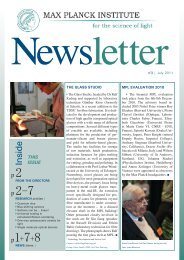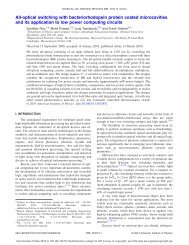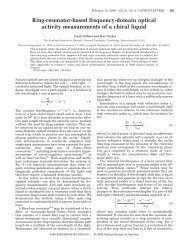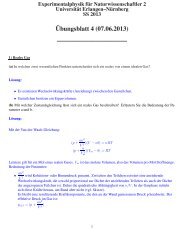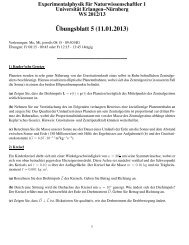REVIEW - Condensed Matter Theory - Imperial College London
REVIEW - Condensed Matter Theory - Imperial College London
REVIEW - Condensed Matter Theory - Imperial College London
Create successful ePaper yourself
Turn your PDF publications into a flip-book with our unique Google optimized e-Paper software.
carrying wire are predominantly magnetic). On<br />
resonance, the Swiss roll structure transmitted the<br />
incident field pattern across the slab (Fig. 1B), and<br />
the resolution matched that predicted by theory.<br />
The image transference was also demonstrated<br />
in an MRI machine (4). Here, the same<br />
M-shaped antenna was used both as the source<br />
of the RF excitation field and as the detector for<br />
the signal, and the metamaterial was tested<br />
twice over. First, it had to transmit the excitation<br />
field without degradation of spatial information<br />
so that the required spin pattern was<br />
excited in the sample. Second, the signal from<br />
that spin pattern had to be conveyed faithfully<br />
back to the receiver. This experiment demonstrated<br />
that a high-performance metamaterial<br />
could act as a magnetic face plate and convey<br />
information from one side to the other without<br />
loss of spatial information (Fig. 1C).<br />
Medical imaging is but one example of the<br />
potential utility of artificial magnetic materials.<br />
Although artificial magnetic metamaterials<br />
R EVIEW<br />
Fig. 1. (A) A single element of Swiss roll metamaterial. (B) An array of such<br />
elements is assembled into a slab and the RF magnetic field from an<br />
M-shaped antenna, placed below the slab, is reproduced on the upper<br />
surface. The red circles show the location of the rolls, which were 1 cm in<br />
diameter. (C) The resulting image taken in an MRI machine, showing that<br />
the field pattern is transmitted back and forth through the slab.<br />
have unique properties, at these lower frequencies<br />
magnetism is also exhibited by existing<br />
conventional materials. As we look to higher<br />
frequencies, on the other hand, conventional<br />
magnetism tails off and artificial magnetism<br />
may play an increasingly important role.<br />
A frequency range of particular interest occurs<br />
between 1 and 3 THz, a region that represents a<br />
natural breakpoint between magnetic and electric<br />
response in conventional materials. At lower frequencies,<br />
inherently magnetic materials (those<br />
whose magnetism results from unpaired electron<br />
spins) can be found that exhibit resonances. At<br />
higher frequencies, nearly all materials have electronic<br />
resonances that result from lattice vibrations<br />
or other mechanisms and give rise to electric<br />
response. The mid-THz region represents the<br />
point where electric response is dying out from the<br />
high-frequency end and magnetic response is dying<br />
out from the low-frequency end: Here, nature<br />
does not provide any strongly dielectric or magnetic<br />
materials.<br />
Metamaterials, on the other hand, can be<br />
constructed to provide this response. At higher<br />
frequencies, the split ring resonator (SRR),<br />
another conducting structure, can be conveniently<br />
used to achieve a magnetic response<br />
(1). The SRR consists of a planar set of<br />
concentric rings, each ring with a gap. Because<br />
the SRR is planar, it is easily fabricated<br />
by lithographic methods at scales appropriate<br />
for low frequencies to optical frequencies.<br />
Recently, an SRR composite designed to<br />
exhibit a magnetic resonance at THz frequencies<br />
was fabricated (5). The size of the SRRs<br />
was on the order of 30 m, 10 times smaller<br />
than the 300-m wavelength at 1 THz. Scattering<br />
experiments confirmed that the SRR<br />
medium had a magnetic resonance that could<br />
be tuned throughout the THz band by slight<br />
changes to the geometrical SRR parameters.<br />
Both the Swiss roll metamaterial and the<br />
THz SRR metamaterial illustrate the advantage<br />
of developing artificial magnetic response.<br />
But metamaterials can take us even<br />
further, to materials that have no analog in<br />
conventional materials.<br />
Negative Material Response<br />
A harmonic oscillator has a resonant frequency,<br />
at which a small driving force can produce<br />
a very large displacement. Think of a<br />
mass on a spring: Below the resonant frequency,<br />
the mass is displaced in the same<br />
direction as the applied force. However,<br />
above the resonant frequency, the mass is<br />
displaced in a direction opposite to the applied<br />
force. Because a material can be modeled<br />
as a set of harmonically bound charges,<br />
the negative resonance response translates<br />
directly to a negative material response, with<br />
the applied electric or magnetic field acting<br />
on the bound charges corresponding to the<br />
force and the responding dipole moment corresponding<br />
to the displacement. A resonance in<br />
the material response leads to negative values<br />
for ε or above the resonant frequency.<br />
Nearly all familiar materials, such as glass<br />
or water, have positive values for both ε and<br />
. It is less well recognized that materials are<br />
common for which ε is negative. Many<br />
metals—silver and gold, for example—<br />
have negative ε at wavelengths in the visible<br />
spectrum. A material having either (but<br />
not both) ε or negative is opaque to<br />
electromagnetic radiation.<br />
Light cannot get into a metal, or at least it<br />
cannot penetrate very far, but metals are not<br />
inert to light. It is possible for light to be<br />
trapped at the surface of a metal and propagate<br />
around in a state known as a surface<br />
plasmon. These surface states have intriguing<br />
properties which are just beginning to be<br />
exploited in applications (6).<br />
Whereas material response is fully characterized<br />
by the parameters ε and , the optical<br />
properties of a transparent material are often<br />
more conveniently described by a different parameter,<br />
the refractive index, n, given by n <br />
ε. A wave travels more slowly in a medium<br />
such as glass or water by a factor of n. All<br />
known transparent materials possess a positive<br />
index because ε and are both positive.<br />
Yet, the allowed range of material response<br />
does not preclude us from considering<br />
a medium for which both ε and are negative.<br />
More than 35 years ago Victor Veselago<br />
pondered the properties of just such a medium<br />
(7). Because the product ε is positive,<br />
taking the square root gives a real number for<br />
the index. We thus conclude that materials<br />
with negative ε and are transparent to light.<br />
There is a wealth of well-known phenomena<br />
associated with electromagnetic wave<br />
propagation in materials. All of these phenomena<br />
must be reexamined when ε and <br />
are simultaneously negative. For example,<br />
the Doppler shift is reversed, with a light<br />
source moving toward an observer being<br />
down-shifted in frequency. Likewise, the<br />
www.sciencemag.org SCIENCE VOL 305 6 AUGUST 2004 789





